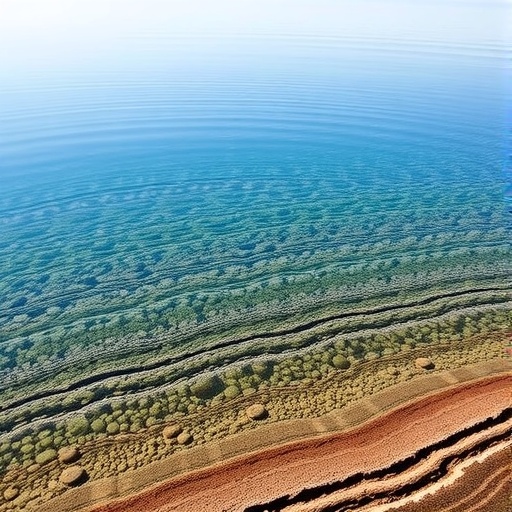Coastal ecosystems are increasingly recognized for their ecological significance and biodiversity. Among these environments, benthic habitats—the regions at the lowest levels of a body of water—play a crucial role in maintaining aquatic life and contributing to ecosystem health. A new study by Forsblom and colleagues, published in Ambio, presents groundbreaking findings on how particulate accumulated matter can serve as a reliable indicator of the condition of coastal benthic habitats. This research is timely and highlights the pressing need to monitor and manage such vital ecosystems effectively.
The accumulation of particulate matter in coastal areas often reflects human activities, including pollution and sedimentation from land development, agriculture, and other industrial practices. Forsblom et al. have delved into this relationship, exploring how these accumulated sediments not only shape the physical landscape of benthic habitats but also affect the organisms that inhabit them. By understanding these interactions, researchers can gauge the health of these ecosystems and predict their responses to environmental changes.
One of the central arguments of the study is that particulate accumulated matter contains crucial information about the environmental history and current condition of benthic habitats. The authors employed sophisticated analytical techniques to characterize the chemical and biological properties of the accumulated matter across diverse coastal regions. This comprehensive approach allowed them to create detailed profiles of various benthic environments, establishing a clear link between particulate matter and habitat health.
Furthermore, the study emphasizes the importance of conducting longitudinal assessments of particulate matter. Forsblom and his team point out that a snapshot of accumulated sediments might not provide a full picture of a habitat’s health. Continuous monitoring can unveil temporal changes and highlight trends that may indicate underlying issues; for instance, shifts in nutrient levels can signify an increase in organic pollution potentially detrimental to marine life.
The researchers also addressed the biological implications of particulate accumulation. By analyzing how specific taxa respond to changes in sediment characteristics, they provide compelling evidence for the interconnectedness of physical and biological systems in marine environments. For example, certain benthic organisms thrive in sediment-rich areas where organic matter is abundant, while others may be adversely affected by the same conditions, leading to shifts in community structure.
Moreover, the findings of Forsblom et al. extend beyond individual species interactions to encompass broader ecological consequences. Changes in benthic community dynamics can have cascading effects throughout the food web, influencing not only local fauna but also fish populations and even human communities reliant on these ecosystems for their livelihoods. Hence, understanding particulate matter accumulation is crucial not just for ecological reasons but also for social and economic sustainability.
A particularly noteworthy aspect of the study is its implications for management and policy frameworks concerning coastal regions. Forsblom and his colleagues suggest that integrating particulate matter assessments into existing environmental monitoring programs can vastly improve our capacity to manage coastal habitats. Decision-makers can utilize such data to identify at-risk areas, allocate resources efficiently, and formulate effective conservation strategies.
The study also lays the groundwork for future research endeavors. The methodologies established by Forsblom et al. can be applied or adapted for assessments in various geographical contexts. Coastal regions worldwide face different pressures, but the analytical frameworks used in this study can yield valuable insights into the conditions of analogous habitats around the globe.
As we face the challenges posed by climate change, urbanization, and pollution, the urgency of implementing effective monitoring strategies becomes ever more apparent. The work by Forsblom and his team underscores the need to bridge scientific knowledge and practical application in coastal management. By doing so, we may better prepare ourselves for the unpredictable ecological shifts that could redefine coastal ecosystems in the coming decades.
The role of citizen science also emerges as a pivotal element in advocating for coastal health. The research illustrates how engaging the public in monitoring efforts can foster a sense of stewardship and responsibility for preserving coastal environments. By raising awareness and involving local communities in data collection efforts, a collective responsibility can be cultivated, ensuring that these ecosystems are valued and protected.
In conclusion, Forsblom et al.’s investigation into particulate accumulated matter as an indicator of coastal benthic habitat condition facilitates a much-needed conversation about the health of our oceans. This research not only advances our scientific understanding but also equips policymakers, conservationists, and the public with essential information to make informed decisions regarding coastal ecosystems. As the urgency of addressing environmental challenges escalates, studies like this illuminate pathways forward, inspiring both action and hope for the future of our planet’s precious aquatic habitats.
With the findings published in Ambio, the momentum towards improving coastal ecosystem management continues to build. The scientific community’s attentiveness to the implications of particulate matter is expected to spur further inquiry, leading to enhanced methodologies and frameworks that can robustly support the conservation of our coastal environments. As the world continues to evolve, adaptability and collaboration will be key in safeguarding the integrity of our planet’s coastline and the myriad forms of life that inhabit them.
Subject of Research: Coastal benthic habitat condition and particulate accumulated matter.
Article Title: Particulate accumulated matter as an indicator of coastal benthic habitat condition.
Article References: Forsblom, L., Takolander, A., Kaskela, A. et al. Particulate accumulated matter as an indicator of coastal benthic habitat condition. Ambio (2025). https://doi.org/10.1007/s13280-025-02249-y
Image Credits: AI Generated
DOI: 10.1007/s13280-025-02249-y
Keywords: Coastal ecosystems, benthic habitats, particulate matter, environmental monitoring, biodiversity, ecosystem health, marine conservation, habitat management.




